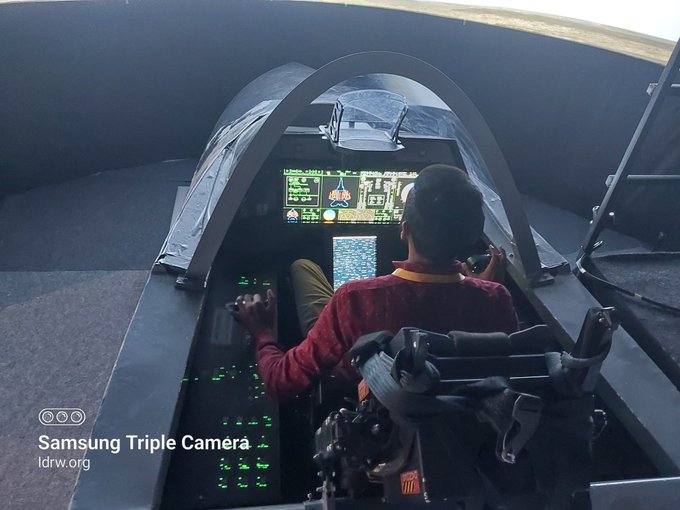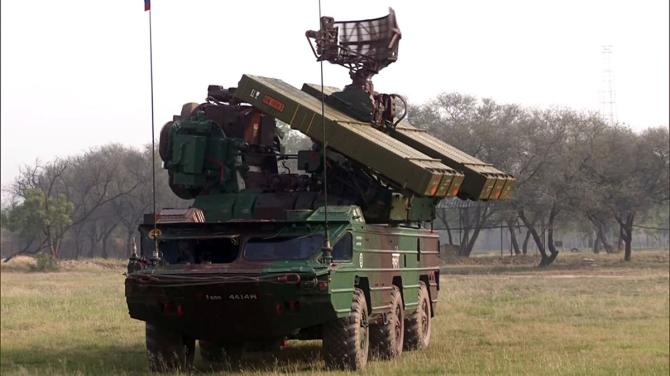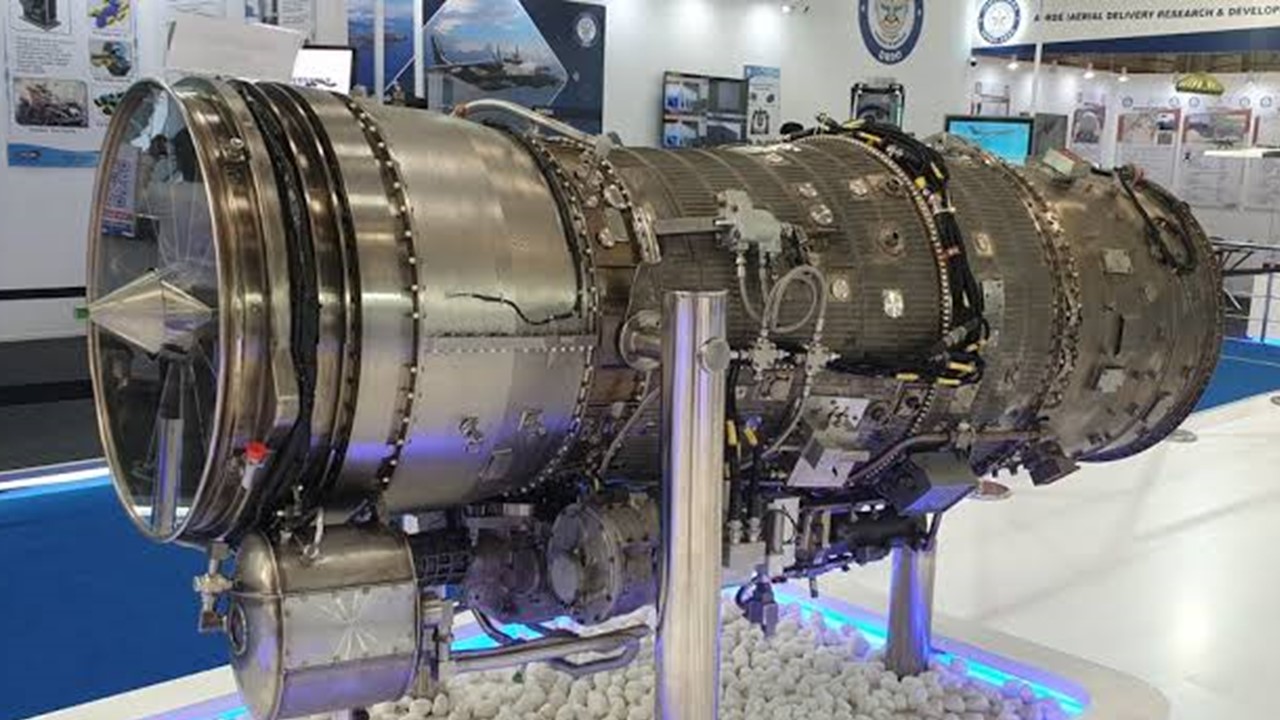SOURCE: RAUNAK KUNDE / NEWS BEAT / IDRW.ORG

In a significant stride towards bolstering India’s indigenous defense capabilities, Samtel Avionics, a leading Indian aerospace and defense electronics company, has developed an advanced Smart Wide Area Display (WAD) for the cockpit of the Advanced Medium Combat Aircraft (AMCA). Puneet Kaura, Managing Director and CEO of Samtel Avionics, recently announced that the company has proposed this state-of-the-art display system for integration into the AMCA, India’s ambitious 5th-generation fighter jet program, which has received clearance for development from the Indian Air Force (IAF).
The AMCA, designed to be a stealth, multi-role fighter jet, is poised to become a cornerstone of India’s air defense strategy. A key feature of its advanced cockpit is the adoption of a next-generation glass cockpit, which will incorporate cutting-edge avionics to enhance pilot situational awareness and operational efficiency. According to Kaura, Samtel’s Smart Wide Area Display is a pivotal component of this modern cockpit, designed to provide pilots with an intuitive and highly functional interface.
Continue readingSOURCE: AFI

In a recent statement, Pakistan’s prominent defence analyst Bilal Khan has cast doubt on Islamabad’s claims of successfully targeting and destroying India’s advanced S-400 air defence systems and BrahMos supersonic cruise missile units. According to Khan, these assertions appear to be primarily aimed at domestic audiences, lacking credible evidence to substantiate them.
Independent open-source intelligence (OSINT) analyses, including satellite imagery, have further failed to confirm any such destruction on Indian territory, raising questions about the veracity of Pakistan’s narrative and suggesting that any plans to strike these assets may have fallen short.
Continue readingSOURCE: AFI
In a surprising turn of events, China’s Ministry of National Defence has debunked claims by Pakistan’s Inter-Services Public Relations (ISPR) that the PL-15E air-to-air missiles recovered by India during recent hostilities were mere “fake models” or exhibition pieces. The Chinese spokesperson’s confirmation that the missiles are genuine has not only contradicted Pakistan’s narrative but also raised questions about the reliability of ISPR’s statements and the strategic implications of the PL-15E’s combat deployment.
The PL-15E, an export variant of China’s advanced PL-15 beyond-visual-range air-to-air missile (BVR-AAM), has been a focal point of recent military tensions between India and Pakistan. On May 7, 2025, debris from PL-15E missiles was recovered in India’s Hoshiarpur, Punjab, following intense aerial skirmishes, marking the missile’s first confirmed combat use by the Pakistan Air Force (PAF). The PL-15E, with a reported range of 145 km, is integrated with Pakistan’s JF-17 Block III and J-10CE fighters, enhancing its long-range air combat capabilities. The domestic Chinese version, in contrast, boasts a range of 200–300 km, making it a formidable weapon in China’s arsenal.
Continue readingSOURCE: AFI

The Pakistan Air Force (PAF) is reportedly planning to relocate the surviving elements of its No. 53 Airborne Early Warning (AEW) Squadron, known as the ‘Hawks,’ to PAF Base Samungli in Quetta. This decision follows a significant attack on PAF Base Bholari on May 10, 2025, which targeted the squadron’s assets and infrastructure.
PAF Base Bholari, located in Sindh, has served as the primary hub for the No. 53 AEW Squadron, which operates the PAF’s critical airborne early warning and control (AEW&C) aircraft, including the Saab 2000 Erieye and ZDK-03 Karakorum Eagle platforms. These assets are vital for providing real-time situational awareness, command, and control during air operations. The May 10 attack, reportedly carried out by a militant group, caused damage to the base, raising concerns about the security of high-value assets stationed there.
Continue readingSOURCE: AFI

The Bangladesh Navy is poised to significantly bolster its maritime capabilities through advanced negotiations with South Korea for the acquisition of six Improved Jang Bogo-class (KSS-I) submarines, valued at approximately $2 billion. This move is part of a broader strategy to enhance deterrence in the Bay of Bengal, particularly against regional powers like India and Myanmar, while safeguarding Bangladesh’s maritime interests, including its Exclusive Economic Zone (EEZ), offshore energy resources, and fishing grounds.
The Bangladesh Navy’s pursuit of six Improved Jang Bogo-class submarines, based on the German Type 209/1400 design and manufactured by Daewoo Shipbuilding & Marine Engineering (DSME), marks a significant step in modernizing its underwater fleet. These submarines will be stationed at the newly constructed BNS Pekua submarine base near Cox’s Bazar, built by China’s Poly Technologies at a cost of $1.29 billion. The acquisition aligns with Bangladesh’s maritime strategy to ensure persistent surveillance, deterrence, and operational flexibility in the Bay of Bengal, particularly in response to growing submarine activity from neighboring countries.
Continue readingSOURCE: PTI
Air India will look to send its wide-body planes, whose heavy maintenance is being done by Turkish Technic, to other MRO entities, as part of recalibrating its plans taking into cognisance the recent developments related to Turkiye, according to the airline’s CEO Campbell Wilson.
Against the backdrop of Turkiye backing Pakistan and condemning India’s strikes on terror camps in the neighbouring country in May, aviation security watchdog BCAS, on May 15, revoked the security clearance for Turkish company Celebi Airport Services India Pvt Ltd in the “interest of national security”.
Continue readingSOURCE: PTI

The Indian Army is conducting field trials of several cutting-edge defence systems under ‘near-combat conditions’, integrating electronic warfare simulations, to assess their performance rigorously, officials said on Saturday.
The trials aim to strengthen the Army’s technological prowess and enhance its operational readiness. The platforms undergoing evaluation include Unmanned Aerial Systems (UAS), UAV Launched Precision Guided Munition (ULPGM), Runway Independent (RWI) Remotely Piloted Aerial Systems (RPAS) and counter-UAS solutions, the defence ministry said.
Continue readingSOURCE: IANS

An all-party Indian delegation on the Operation Sindoor diplomatic outreach, led by JD-U MP Sanjay Kumar Jha, paid heartfelt homage to the Malaysian national who lost her life in the 26/11 Mumbai terror attack.
The Indian High Commission in Malaysia took to X to highlight the solemn moment and the delegation’s engagement with Malaysian civil society and media. “All-Party Parliamentary Delegation, led by Hon’ble MP Mr. Sanjay Kumar Jha, interacted with representatives from leading Malaysian media houses and social media influencers. Briefed them about the purpose of their visit, meetings with Malaysian interlocutors and the new normal in India’s zero tolerance against terrorism. The delegation also paid homage to the Malaysian national who lost her life in the Mumbai terror attack in 2008 (26/11 attacks) and brought out the threat posed by terrorism to whole of mankind,” the Indian mission posted.
Continue readingSOURCE: PTI

With opposition parties demanding a special Parliament session in light of Operation Sindoor, Union Minister Gajendra Singh Shekhawat on Sunday asserted that the government has nothing to hide and they will have ample opportunity to ask questions during the Monsoon Session, which is a few weeks away.
The BJP leader, however, expressed doubts about whether the opposition parties intended to seek answers and pointed out that Prime Minister Narendra Modi had spoken extensively in recent days on key national issues, including Operation Sindoor, that they have been raising.
Continue readingSOURCE: IANS

Ukraine’s “massive” strike on Russian strategic assets across the length and breadth of the country was a meticulously planned operation that was over a year in the making and reportedly involved the insertion of drones close to their targets.
As per X user Maria Avdeeva, who describes herself as a “security expert covering invasion from day one” and “countering Russian disinformation since 2014”, Ukraine had secretly delivered FPV drones and wooden mobile cabins into Russia, with the drones were hidden under the roofs of the cabins, which were later mounted on trucks.
Continue readingSOURCE: IANS

A day before Russian and Ukrainian delegations are scheduled to meet in Istanbul for the second round of talks on ending their conflict, Ukraine on Sunday claimed a massive strike on Russian strategic aviation assets in Siberia, Murmansk in the north and other places.
While Ukraine’s President Volodymyr Zelensky said earlier on Sunday that a delegation will be going to Turkey with the main aim of reaching a “complete and unconditional ceasefire”, and Russian media also reported that a Russian delegation has departed for the talks in Turkey, how this dramatic escalation will play out on the course of negotiations remains to be seen.
Continue readingSOURCE: PTI
Air Marshal Manish Khanna, an accomplished officer with over 4,000 hours of flying experience on various fighter and trainer aircraft, on Sunday assumed the charge of the Southern Air Command.
He was commissioned in the fighter stream of the Indian Air Force on December 6, 1986, the government said in a statement. “Air Marshal Manish Khanna Ati Vishisht Seva Medal (AVSM), Vayu Sena Medal (VM), assumed command of the Southern Air Command (SAC) as Air Officer Commanding-in-Chief on June 1, 2025 at Thiruvananthapuram,” it said.
Continue readingSOURCE: IANS

A 22-year-old Tanzanian naval trainee went missing after reportedly jumping into the Kochi backwaters on Sunday evening while spending time with fellow cadets. The missing individual has been identified as Abdul Ibrahim Salih, who had arrived in Kochi earlier in the day after completing his naval training at the Indian Naval Academy in Ezhimala.
Salih had participated in the prestigious passing out parade held at Ezhimala on Saturday, marking the successful conclusion of his training. He travelled to Kochi with other international and Indian cadets for a short break before returning home.
Continue readingSOURCE: IDRW.ORG

In a significant development for India’s maritime defense, Mazagon Dock Shipbuilders Limited (MDL) is poised to sign a contract in June 2025 for the construction of three additional Kalvari-class (Scorpene) submarines for the Indian Navy. This deal, valued at approximately ?38,000 crore (US$4.5 billion), marks a critical step in strengthening India’s underwater capabilities and advancing its self-reliance in defense manufacturing under the Aatmanirbhar Bharat initiative.
The new submarines, to be built in collaboration with France’s Naval Group, will incorporate cutting-edge technologies, including an indigenous Air Independent Propulsion (AIP) system, making them more potent than their predecessors.
Continue readingSOURCE: IDRW.ORG

In a significant push toward self-reliance in aerospace technology, the Defence Metallurgical Research Laboratory (DMRL), a premier lab under India’s Defence Research and Development Organisation (DRDO), has released an Expression of Interest (EoI) for a Development Contract focused on machining aero-engine turbine blades and vanes. Specifically, the contract involves High-Pressure Turbine (HPT) blades and vanes, utilizing customer-supplied Single Crystal Nickel Superalloy Castings, as announced on April 19, 2025, via posts on X.
DMRL has been at the forefront of developing advanced materials for India’s defence applications, particularly in aerospace. The lab has already established expertise in producing state-of-the-art Directionally Solidified (DS) and Single Crystal (SX) blades and vanes through vacuum investment casting—a process critical for aero gas turbine engines that demand high efficiency, thrust, and low fuel consumption. These components, made from advanced nickel-based superalloys, are designed to withstand extreme temperatures and stresses, making them essential for modern military aircraft and helicopters.
Continue reading